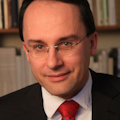How do European companies develop quantum technologies?
Quantum technology: where does it stand? Which products are feasible or being developed? Where is a market for quantum technology (QT)? These questions were the focus of the quantum technology and photonics symposium at the AKL ‘22 – International Laser Technology Congress in Aachen, Germany. Answers were provided not only by startups, but also by medium-sized and large companies on the first day of the congress, organized by the Fraunhofer Institute for Laser Technology (Fraunhofer ILT).
What’s the state of quantum technology in Europe?
Even for laser experts, it’s still a challenge to follow the many developments across quantum technology. Getting an update on the current situation from a senior expert is great, even if he speaks as fast as Tommaso Calarco. He is not only coauthor of the quantum manifesto from 2016, but also director of the Institute for Quantum Control, Peter Grünberg Institute at Forschungszentrum Jülich. He took the audience on a journey through the current European QT landscape. We’ve reached the noisy intermediate-scale quantum (NISQ) era with different quantum processors. But these quantum computers are not advanced enough to reach fault-tolerance, nor do they reach real quantum supremacy. Calarco made a remarkable comparison: Today’s quantum experiments resemble the first flight of the Wright brothers—while not much faster than a pedestrian, it showed a superior principle. And a wide range of different technologies are evolving within the quantum arena.
German big tech engages with quantum technology
Big tech usually refers to the likes of Apple, Google, or Huawei, but Germany has a few famous market leaders. For example, Robert Bosch GmbH is the market leader for smartphone motion sensors. And Bosch is the world’s largest supplier to automotive industry—in 2020, their revenue was €71.5 billion ($79 billion) with about 400,000 employees.
Bosch’s engagement with quantum projects started as early as 2013, Bosch’s chief expert for quantum technologies Robert Strohm reported at AKL’22. The company engages with projects in quantum sensing and quantum cryptography, as well as quantum computing.
Strohm presented a few of them in quantum computing. While this often looks like “A solution seeking for a problem,” people at Bosch develop quantum algorithms already for real-world research. They simulate new materials for fields such as fuel cells to explore how long they’ll live. Strohm says real materials are still too complex to simulate and there is no quantum advantage yet in such calculations. But there are first results, and he presented use cases from optimization problems: How do you control a welding process with process data and machine learning without photos? How can you recognize people without seeing their faces? These are a few of a dozen cases he discussed in Aachen.
Infineon was another big player presenting at AKL ‘22. It’s Germany’s last full-scale semiconductor provider with a turnover of about €11 billion ($12 billion). Infineon has 20 manufacturing sites and 56 R&D locations. Quantum activities are being adopted throughout all four business segments. Sebastian Luber, senior director technology & innovation at Infineon Technologies, presented quantum sensing and quantum computing. For the latter, Infineon is pursuing several different concepts. In all cases, they use their extensive semiconductor know-how to develop components compatible with existing production technologies.
As a supplier of semiconductor chips, Infineon addresses the hardware layers of a quantum computer architecture and the application. They focus on control electronics, readout electronics, and quantum processing units (QPUs). Luber showed Infineon’s path to superconducting qubits, where they apply their established tunnel junction fabrication processes.
Together with researchers at RWTH Aachen University, FZ Jülich, and Fraunhofer IPMS, they also work on spin qubits on silicon wafers (project QLSI). They’re trying to establish CMOS-like concepts to get an integrated 16-qubit chip. For another project, they’re using their industrial expertise to push ion-trap qubit development using chips from their Villach facility. Luber described entanglement of 24 such qubits at a moderate temperature of 10 K.
Bosch and Infineon are members of the Quantum Technology and Application Consortium (QUTAC), where they pool findings with 10 heavyweights of German industry such as Siemens, BASF, or Volkswagen.
It’s important to note that QUTAC is not QuTech, a Dutch research institute with about 300 people. QuTech was founded in 2014 as a collaboration between Delft University of Technology (TU Delft) and the Netherlands Organisation for Applied Scientific Research (TNO). QuTech’s Wolfgang Tittel spoke in Aachen about their path from single-photon sources to reliable quantum repeaters. These are needed for the quantum internet of the future, when direct fiber connection is replaced by a network structure with nodes.Making profits with quantum technology
Only a few companies can realize serious revenues from QT applications already. Quantum key generation (QKD) is one field where the technology is mature enough to be sold and even standardized. For secure communication, the actual thread is the decryption with the evolving quantum computers, as ADVA’s Helmut Griesser pointed out. For ADVA, a German market leader in communication technology, QKD is just one tool among several they sell for quantum-safe cryptography.
A second group of companies making money with QT provide the precision-laser equipment for quantum experiments. In Aachen, three of them—Toptica Photonics, Menlo Systems, and NKT Photonics—discussed their path to quantum markets. They are deeply involved in QT research and development projects for many years already. Based on this experience, Ronald Holzwarth of Menlo Systems recommends careful expectation management to avoid disappointment when the rise of QT takes longer than expected. Beside other applications, he sees quantum-based optical clocks on navigation satellites within the future.
Robust fiber-laser modules with small bandwidth can soon become a standard product for quantum technology, as Thorge Holm from NKT showed. They have sold more than 15,000 such modules, mostly for semiconductor inspection. Now, they want to offer these industrial lasers for quantum computing.
Wilhelm Kaenders, founder and president of Toptica Photonics, has been following this QT path for quite some time already. Toptica developed a wide range of precision lasers for metrology and scientific applications that sell well within the QT market. Kaenders sees “quantum excitement everywhere”. But he also expressed concerns that the development of quantum technologies is increasingly limited by national interests. For Toptica, this problem has arrived in daily business where they need to fill out an increasing number of export license applications for their lasers.
QT startup world
QT startups have made many headlines during recent months with mergers and acquisitions. But after all headlines and investments rounds, one important question remains: When can they sell a first product? Startup Q.ANT, which is backed by the Trumpf Group, has reached this milestone, as CEO Michael Förtsch reported in Aachen. With a team of 50 employees, the company has three quantum sensors in its product pipeline. Their particle sensor is currently undergoing trials with customers, including German chemical giant BASF.“As a startup, we come from the laser industry, not from academic research,” Förtsch says. “Quantum technology is not a value in itself, it has to offer a substantial benefit to be bought”—a fact familiar from the introduction of laser technology to the market. But the evolution of laser technology during the past 60 years leads to one more conclusion: QT, and quantum computing in particular, may solve an entirely new class of problems.
QT takeaways
What are the main takeaways from the forum? Bernd Jungbluth, from Aachen’s Fraunhofer ILT and chair of the forum, sums up his impressions: “It was amazing to see how broad industry giants like Bosch and Infineon are positioned.” They are using their full technological strengths to approach a wide range of different applications, and the progress they’ve made within the past two years is impressive.
The second chairman of the forum, Florian Elsen of Fraunhofer ILT, adds, “Fraunhofer ILT develops photonic solutions for quantum technologies, which are important tools for enabling the quantum future. One challenge here is to optimize ultrastable sources for scalability, reproducibility, and maturity in continuous use.” While the prospects of QT are still a little vague, it can be seen as a safe bet that such laser systems will be the workhorses for various forms of quantum applications. Serving the quantum internet or tiny quantum computers, these precision lasers will follow a development path similar to telecom systems and become small reliable systems.
About the Author
Andreas Thoss
Contributing Editor, Germany
Andreas Thoss is the Managing Director of THOSS Media (Berlin) and has many years of experience in photonics-related research, publishing, marketing, and public relations. He worked with John Wiley & Sons until 2010, when he founded THOSS Media. In 2012, he founded the scientific journal Advanced Optical Technologies. His university research focused on ultrashort and ultra-intense laser pulses, and he holds several patents.



